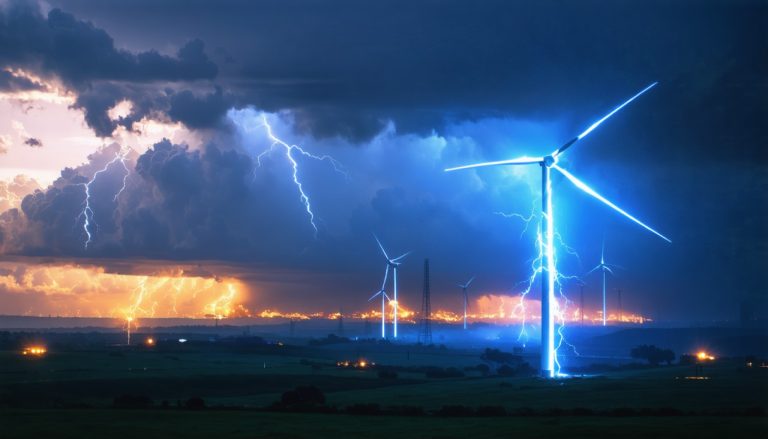
- The Powering AI: Global Leadership Summit at Oklahoma State University focused on integrating AI advancements with American energy innovation.
- High-profile leaders, including four U.S. cabinet members, emphasized the need for unity and strategic energy advancements to support AI growth.
- Dr. Ann Bluntzer Pullin highlighted the urgency of blending innovation with energy sector leadership to ensure America’s dominance in AI.
- U.S. Secretary of Energy Chris Wright proposed modernized infrastructure and energy expansion as essential components for supporting AI development.
- The summit stressed the importance of utilizing rural America’s potential for innovation and sustainable growth.
- The consensus was clear: to maintain a competitive edge in AI, the U.S. must prioritize robust energy readiness and infrastructure.
A nexus of groundbreaking potential unfolded at Oklahoma State University’s Hamm Institute for American Energy on Thursday, where thought leaders from technology, energy, and academia assembled for the Powering AI: Global Leadership Summit. Against the vibrant backdrop of Oklahoma’s dynamic horizons, these trailblazers charted a course for a monumental challenge: fueling the rapid ascent of artificial intelligence with resilient American energy.
This summit, an unprecedented confluence of intellect and ambition, underscored a pivotal realization—America stands at a crossroads where its prowess in AI could either soar or stagnate, contingent upon its energy innovation. The stage was set with luminary figures including four U.S. cabinet members, all echoing a resonant call for unity in ambition and action.
Dr. Ann Bluntzer Pullin, at the helm of the Hamm Institute, depicted the urgency with a vivid metaphor of acceleration. She emphasized the convergence of innovation and implementation, orchestrating an alliance that echoes the ethos of progress without parallel. The essence was simple yet profound: for America to lead in AI, it must unapologetically commandeer the energy sector.
Within the summit’s spirited dialogues, U.S. Secretary of Energy Chris Wright laid out a vision of energy expansion entwined with modernized infrastructure—a symbiosis necessary to propel the country’s AI ambitions. The discussions were not mere rhetoric but were scaffolded by strategic foresight, aiming to catapult the United States into the vanguard of global technological advancement.
Energy Secretary Wright, along with Agriculture Secretary Brooke Rollins and EPA Administrator Lee Zeldin, embodied the strategic alignment needed to harness the potential of rural America in this energetic renaissance. Rollins, with a palpable passion, unveiled the USDA’s readiness to spearhead efforts—transforming rustic landscapes into epicenters of innovation and sustainable growth.
Beneath the weight of these deliberations lay a core truth: America’s edge in AI demands not just a surge of innovation but a tidal wave of energy readiness. This summit was more than a dialogue; it was the inception of a strategy to power brilliance with brawn. As these leaders forged a pathway towards an electrified future, they illuminated a critical insight for all to ponder: the age of AI is here, but it thrives not just on code and data, but on a charged grid of unfaltering energy.
Powering the AI Revolution: How Energy Innovation Will Propel America’s Future
The Intersection of AI and Energy: A Pivotal Moment
The recent “Powering AI: Global Leadership Summit” at Oklahoma State University’s Hamm Institute for American Energy marked a significant turning point, emphasizing the critical intersection of artificial intelligence and energy innovation. Key figures, including U.S. Secretary of Energy Chris Wright, emphasized that America’s leadership in AI hinges on energy resilience and modernization. This underscores the urgent need to align technological advancements with sustainable energy solutions.
Key Insights and Industry Trends
1. AI’s Energy Demand: As AI systems become increasingly complex and pervasive across industries, their energy demand rises significantly. This necessitates more robust and efficient energy infrastructures capable of managing high loads consistently. According to a 2021 study by the International Energy Agency, energy consumption of AI and data centers is projected to increase rapidly, necessitating innovative power solutions.
2. Innovative Energy Solutions: Potential solutions discussed at the summit include tapping into renewable resources and modernizing the national grid. This aligns with global trends pushing for clean energy initiatives and reducing carbon footprints. The U.S. government’s commitment to renewable energy is evident through incentives and policy efforts aimed at reducing dependency on non-renewable sources.
3. Collaboration Across Sectors: The summit highlighted the need for collaboration across government, technology, and agricultural sectors. By integrating efforts, the aim is to transform rural areas into innovation hubs, leveraging USDA programs to support infrastructure development in less urbanized regions.
Pressing Questions and Expert Opinions
– How can AI contribute to sustainable energy?
AI can optimize energy consumption and distribution. For instance, AI algorithms can predict energy demand patterns, thus helping in the efficient allocation of renewable resources like wind and solar power.
– What are the potential risks and challenges?
While AI offers promising advancements, it also poses risks such as increased cybersecurity threats and ethical challenges in algorithmic bias. Robust cybersecurity measures and ethical governance must evolve alongside technological innovations.
Actionable Recommendations
1. Invest in Renewable Energy Sources: To support AI’s energy needs, investment in solar, wind, and hydroelectric power can help create a more sustainable energy ecosystem. These investments not only support AI development but also align with broader environmental goals.
2. Enhance Energy Efficiency: Companies can implement AI-driven solutions to optimize the energy efficiency of data centers and reduce operational costs, an essential step in managing the increasing energy demands of AI technologies.
3. Foster Education and Collaboration: Establish educational programs and partnerships between academic institutions and industry leaders to develop the next generation of energy and AI innovators.
Conclusion
As we stand on the brink of a new technological era, the synergy between AI and energy innovation is vital for America’s sustained leadership in global technology. By prioritizing sustainable energy practices, fostering cross-sector collaboration, and investing in renewable sources, the U.S. can support AI’s growth while ensuring environmental stewardship.
For further insights on the intersection of energy and technology, visit the U.S. Department of Energy or the Oklahoma State University sites.
Video Resource
Consider watching the webinar recordings or panel discussions from the summit available through Oklahoma State University’s media channels to gain further insights into the strategies discussed.
Quick Tips
– Adopt smart home technologies to contribute to energy savings.
– Stay informed about local and federal incentives for renewable energy installations.
– Encourage community programs that promote energy literacy and AI education, strengthening communal efforts in sustainable practices.



